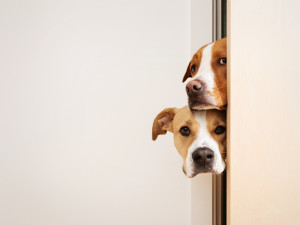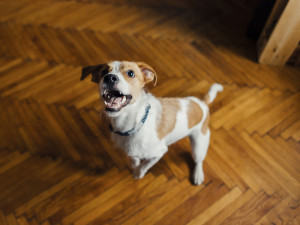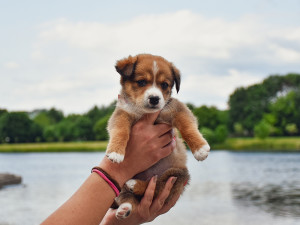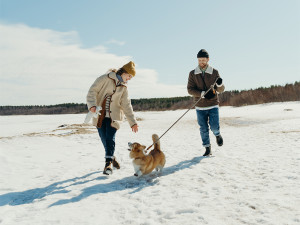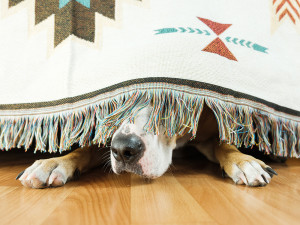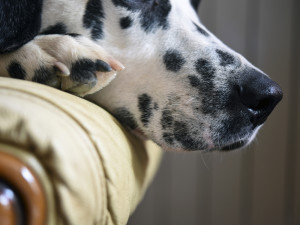How to Keep Your Dog From Freaking Out When You Have Company
Do these things to help your pup (and your guests) feel chill

Share Article
If your dog gets upset when you have people over, you’re not alone. I get calls every week from people who want help with dogs who react badly to anyone who comes into the house. More often than not, these dogs are afraid – but people rarely call to say that they have a fearful dog.opens in a new tab They call to tell me that their dogs are aggressive towards visitors by barkingopens in a new tab, lunging, growling or even bitingopens in a new tab people.
Comprehensive dog training programmes for improving a dog’s emotional state and behaviour when visitors arrive must be individually designed for each dog and each situation. Often, the use of treatsopens in a new tab or favourite toys is involved so that the dog learns that all visitors have something fun and wonderful to offer. When a dog has grasped the strong connection between visitors and good things, happiness can replace fear as the dog’s response to people coming to the house. That’s a very brief and simplified description of what can often be a long and detailed process. Sometimes one simple trick can help. Keep reading to learn what it is and how to try it.

littleKin™ is Kinship’s home just for puppy and kitten parents. Bop over to check out expert advice, new pet tools, and special deals—all curated for your newest family member.
opens in a new tabHow to help a fearful dog handle visitors
Don’t let your dog see a guest enter your home
The trick is to make sure your dog doesn’t see the visitors when they enter. Instead, you want your dog to encounter the guest when they are already settled in the house. It’s a lot easier for a dog to see people already seated in the living room or around the table than it is for them to see people arrive and enter. Having visitors show up at the door is a very intense situation for a fearful dog. The sight, smell and sound of someone other than a family member appearing at the door and entering the home is a big deal to a dog who is not comfortable with new people. It sets off all of their alarm bells (‘Intruder!’).
To avoid that, tell your visitors to call or text right before coming in so you can make sure you have the situation set up to maximise your chances of success. Before opening the door for your visitors, temporarily put your dog in a place out of sight of the entry, such as in a crateopens in a new tab in another room or in the garden. I’ve even had clients briefly put their dog in the car if that is where the dog is most comfortable when not with their humans.
Give your guest treats to earn your dog’s affection
Once your dog is where you want them, let your visitors in, have them sit down, and give them whatever treats or toys your dog loves best. Then, bring your dog into the room and have them give your dog the goodies. Depending on the details of the dog’s issues, you may need to have your dog on a lead or behind a gate during this interaction.
If your dog (or your guest) is uncomfortable, keep your pet separate from them
Some dogs will be fine with people once they have met them in this way, and if that’s the case, then this may be all you have to do during this particular visit. Other dogs may react poorly if anyone stands up or makes any sudden movements, so it may be better to keep them separate from your visitors after the initial exposure. Such dogs can benefit from additional work, but this technique can still be a good first step.
No single method suits every dog, and extra caution is always advisable with dogs who have bitten someone. Still, it is easier for almost all fearful dogs to meet visitors who are already in the house sitting down than it is to meet people as they enter the house. It will take time and patience for your dog to learn this skill. Like everything with dog training, there is no quick fix. But, with the help of a friend or two, a handful of treats, and a little patience, you can help ease your dog’s fear of household visitors.

Karen B. London, PhD, CAAB, CPDT-KA
Karen B. London, Ph.D., is a Certified Applied Animal Behaviorist and Certified Professional Dog Trainer who specializes in working with dogs with serious behavioral issues, including aggression, and has also trained other animals including cats, birds, snakes, and insects. She writes the animal column for the Arizona Daily Sun and is an Adjunct Professor in the Department of Biological Sciences at Northern Arizona University. She is the author of six books about training and behavior, including her most recent, Treat Everyone Like a Dog: How a Dog Trainer’s World View Can Improve Your Lifeopens in a new tab.
Related articles
![A happy looking man and woman walking their dog outside in a large snowy field.]() opens in a new tab
opens in a new tab10 Ways to Make Your Dog’s Life Better
Simple resolutions to boost your dog’s happiness, health and well-being all year long
![Dog hiding under the sofa and afraid to go out because he heard fireworks.]() opens in a new tab
opens in a new tabWhy Are Dogs Scared of Fireworks?
How to keep your dog mentally and physically safe this Bonfire Night
![Shepherd dog playing with yellow ball at the beach]() opens in a new tab
opens in a new tabHow to Keep Your Dog Safe At the Beach
Five tips to help your pup have fun in the sun – safely
![Spotted dog with a close up of his nose]() opens in a new tab
opens in a new tabWhat to Do If Your Dog Has a Cracked, Broken or Torn Nail
A vet explains when you can treat the injury at home – and when it’s best to seek professional help
